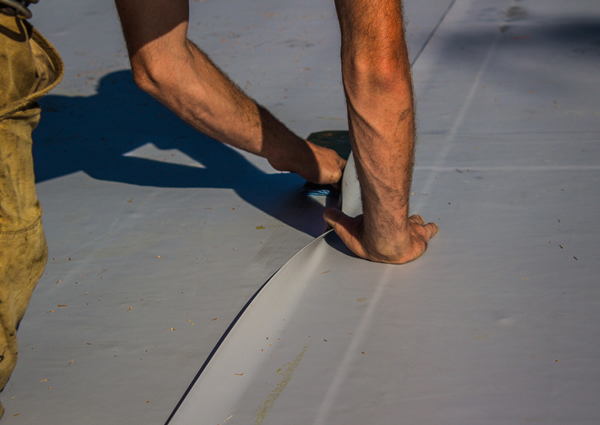The Basics: What is TPO Roofing?
Author: Sheryll Poe | April 21, 2020
When it comes to roofing, there's no shortage of acronyms. One of those is TPO, which stands for thermoplastic polyolefin. So what is TPO roofing? It's actually one of the fastest growing segments of the commercial roofing market — the global TPO roofing membrane market is expected to reach an estimated $2.2 billion by 2024, according to a recent forecast by market research firm Lucintel. Here's everything you need to know about this new membrane on the block.

Getting to Know TPO
TPO roofing is one of several synthetic single-ply roofing membrane options that are used primarily for flat commercial roofing applications.
Despite its name, TPO is actually composed of three layers: a polymer base, a polyester-reinforced fabric center and a TPO-compounded top ply. It comes in three different thicknesses including 45, 60 and 80 mils (a mil is 0.001 of an inch, so 45 mils is equal to 0.045 inches).
What sets TPO apart is its thermoplastic composition, which allows the membrane to be heat-welded at the seams rather than seam-taped like EPDM (ethylene propylene diene monomer) membranes. This allows TPO to create a single, heat-welded, membrane-to-membrane, watertight layer over the entire roof.
Why Commercial Contractors Choose TPO
TPO comes in wide, lightweight sheets that are flexible and easy to install. It's cost-efficient, starting at around $5 per square foot, and is resilient to wear, tear and environmental impacts. A TPO roof should last 10-15 years. Because it is so flexible, TPO can easily accommodate a building that moves or settles.
Few environmental conditions can compromise this highly durable, waterproof material. TPO is resistant to mold or microbial growth, chemicals, grease, oils, UV and ozone, making it the perfect energy-efficient choice for a wide variety of commercial buildings.
TPO is also environmentally friendly. Not only does it keep buildings cooler by reflecting solar rays, it's also made from completely recyclable materials and can be remade into the next generation of roofing materials at the end of its life cycle.
How Does TPO Stack up Against Other Membrane Materials?
There are other single-ply roofing membranes, including EPDM and PVC (polymerizing vinyl chloride), that share many of the same durability and energy-efficient properties as TPO.
EPDM, PVC and TPO have similar installation costs, according to Roofing Calculator, but TPO membranes are lighter and have a slightly higher break and tear resistance than PVC. PVC is also less weather resistant and ages more rapidly in intense heat.
Geography plays a part in determining which roofing membrane might work best. Most light-colored TPO membranes are Energy Star and Cool Roof Rating Council (CRRC) certified, according to the Singly Ply Roofing Industry, and are popular throughout the South and West where the material reflects solar rays. EPDM comes primarily in black, making it more effective for absorbing heat, which is helpful in the North where ice and snow need to melt quickly.
What Other Projects Should Use TPO?
Its resistance to chemicals, grease and oils make TPO the ideal roofing membrane for all manner of manufacturing, industrial and commercial facilities from restaurants to hospitals.
So what is TPO roofing? With its energy-efficient and water-resistant qualities, TPO is a natural choice for flat roof homes, particularly in warm, southern climates.